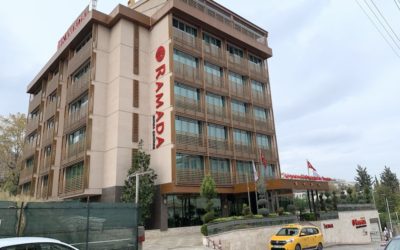>>>Download this article for offline viewing using the GPSMyCity app! Click here.
In 2014, Bursa proudly took its place as inscription number 1452 on the UNESCO World Heritage Site List and was officially recognized for its cultural and historical value as the Birthplace of the Ottoman Empire. Though Bursa was not the first capital city of the Ottoman Empire (nor the last), it was the city where the Ottoman social framework began to take its shape, and the city laid the foundation for the social and cultural infrastructure of the entire Ottoman Empire.
Historical Context
When Bursa was captured from the Byzanties in 1326 by Orhan Gazi (1281-1362), son of Ottoman founder Osman Gazi (1258-1326), the city was a walled citadel situated on a rocky Uludağ outcrop surrounded by a handful of small villages. Orhan Gazi and other early sultans aggressively expanded the city beyond the citadel walls and into the surrounding foothills and plains. The primary component of this expansion, which was to become the focal point of Ottoman social institutions, was the külliye.
A külliye was an Ottoman-era complex that served as the center of social and religious life and generally consisted of a mosque, a tomb, and various social buildings such as a public bath house (hamam), a soup kitchen (imaret), a religious school (madrasah), a health clinic, a commercial area, and a park. Usually surrounded by residential housing, kulliyes can be found in cities throughout the former Empire. Bursa’s külliyes became the prototypical model for Ottoman urban planning and development.
Here’s a short 6-minute video describing the cultural and historical value of Bursa’s külliyes and explaining why the city is worthy to be included on the UNESCO list.
The Bursa UNESCO Site inscription consists of eight properties scattered throughout the city that reflect the urban planning strategy and social organization of the early Empire. These sites include the central bazaar area that encompasses the hans, Grand Mosque (Ulu Cami’i), and Orhan Gazi Külliye; the tombs of Osman and Orhan Gazi; two locations in the Hüdavendigar Külliye of Sultan Murad I; the Yıldırım Külliye of Sultan Bayezid I; the Yeşil Külliye of Sultan Mehmed I; the Muradiye Külliye of Sultan Murad II; and the village of Cumalıkızık. These eight properties are among Bursa’s most interesting and beautiful historical gems, and they are definitely must-see locations when you visit Bursa.
Location 1: Orhan Gazi Külliye and Central Bazaar Area
After Orhan Gazi conquered Bursa, he looked beyond the citadel walls and envisioned the urbanization of the foothills and plains at the base of Uludağ. Some of the first buildings in his development plan included a mosque, a hamam, and a han (commercial trade center). Completed around 1340, this construction project effectively shifted the city center out of the walled citadel. In following years, the city’s main commercial district grew up around Orhan Gazi’s külliye.
Today, Orhan Bey Mosque and Emir Han look and function as they did 700 years ago. The hamam, now known as the Aynalı Kapalı Çarsi, has been converted into a rustic bazaar consisting of interesting antique and souvenir shops. These buildings are tucked away among Bursa’s bustling central bazaars and hans, nearly all of which date back to the first couple centuries of Ottoman rule and still reflect the cultural and social values of the early Ottoman Empire. The UNESCO inscription marks off nearly 11 hectares of property in Bursa’s central bazaar area. In addition to Orhan Gazi Külliye, the inscribed area includes Ulu Cami’i (Grand Mosque), Koza Han, the covered bazaar, and a number of centuries-old hans (commercial trade centers), hamams, mosques, homes, streets, and alleyways.
Location 2: Osman and Orhan Gazi Tombs
Unlike the other sultans laid to rest in Bursa, Orhan Gazi is not entombed in his külliye. Instead, his mausoleum stands next to his father’s inside the gates of Tophane Park in the old hilltop citadel on the grounds of what was once a Byzantine monastery. Completely destroyed in the 1855 earthquake, the tombs were rebuilt in their present form in 1863. The UNESCO inscription encompasses both mausoleums and Tophane Park, including the 19th-century clock tower that looks out across the sprawling city.
Locations 3 & 4: Hüdavendigar Külliye of Sultan Murad I
Sultan Murad I (1326-1389), son of Orhan Gazi, started construction on his külliye in the 1360s in the hillside village of Çekirge. Murad I had the nickname Hüdavendigar, a name which has been applied to his külliye. The külliye consists of a mosque, madrassah, tomb, fountains, and soup kitchen. The madrassah was built into the second floor of the mosque, which is a unique feature among mosques of the period. The soup kitchen was destroyed by earthquake in the 19th century and rebuilt in 1904. The külliye offers a lovely lookout over the west side of the city.
The külliye’s hamam is not located next to the other buildings, but is situated a couple blocks away in Çekirge Square. Known as the Eski Kaplıca Hamamı, the public bath house was built on top an ancient Byzantine bath and is fed by Çekirge’s famous mineral-rich thermal spring.
Location 5: Yıldırım Külliye of Sultan Bayezid I
“Yıldırım” Bayezid I (1360-1403) built his külliye in the 1390s on the east end of the city, thereby pushing the city’s expansion eastward. Originally, the külliye consisted of a mosque, a hamam, a han, madrasahs, soup kitchens, stables, houses, and the first public hospital in the Ottoman Empire. Today, the mosque, hamam, a madrasah, and the hospital remain. The külliye also includes Bayezid’s tomb, which was built in 1406 by one of his sons.
Bayezid I is also credited with building two of Bursa’s most famous structures: Ulu Cami’i (Grand Mosque) and Koza Han (Silk Market).
Location 6: Yeşil Külliye of Sultan Mehmed I
Located between Yıldırım Külliye and the central bazaar area, the Yeşil Külliye was built in 1419 by Mehmet I Çelebi (1381-1421). The complex consists of a mosque, an ornate tomb, a soup kitchen, a madrasah, and a hamam. Today, the madrasah serves as the Turkish Islamic Arts Museum, the soup kitchen is a café, and the hamam has been recently converted into a lovely souvenir shop. All of the külliye’s buildings survive to this day and their blue-green tiles make them some of the most beautiful and interesting buildings in Bursa. The Yeşil neighborhood is a well-preserved remnant of Ottoman urban culture.
Location 7: Muradiye Külliye of Sultan Murad II
Sultan Murad II (1404-1451) built his külliye in 1426 on the west end of the city, expanding the city in a westward direction. Muradiye is Bursa’s last külliye built by Ottoman sultans and is the largest külliye in the city. Richly ornamented, the külliye’s buildings originally consisted of a mosque, hamam, madrasah, a soup kitchen, a health clinic, and a number of fountains, tombs, and cemeteries. The Muradiye Külliye has been recently completely restored and reopened to the public. The complex is surrounded by a lovely green park and is next to the Ottoman House Museum and the Ottoman Clothing and Jewelry Museum.
Location 8: Village of Cumalıkızık
Cumalıkızık is a fantastic, well-preserved 700-year-old village on the Uludağ mountainside east of the city. It is the only location on Bursa’s UNESCO inscription not in the city center. However, not only is the village an outstanding example of early Ottoman rural life, what the village represents is significant to the development of the Ottoman social infrastructure: The city’s külliyes were built with public endowments, and to fund the construction and maintenance of the külliyes, the sultans concurrently built hans (commercial trade centers) and villages as a means of generating income. Cumalıkızık, in particular, was permanently assigned as a waqf (endowment) village to provide income specifically for Orhan Gazi Külliye. Many villages around Bursa were designated as waqf villages, but Cumalıkızık is the most complete remnant of the system and has maintained its character over the centuries. Today, Cumalıkızık is a wonderful place for a good breakfast and a glimpse of the traditional Ottoman ways of rural life.
What about Emir Sultan’s Külliye?
Perhaps one of the city’s most interesting and beautiful külliyes is the Emir Sultan Külliye located on a hill east of Yeşil. The complex dates back to the 15th-century and originally included a mosque, a hamam, a madrasah, and a health clinic. Like other buildings in Bursa, the complex has been destroyed and rebuilt a few times over the centuries. However, the külliye is not included in the UNESCO inscription because Emir Sultan – despite his nickname – was not actually an Ottoman sultan. His real name was Şemseddin Mehmed Ali el-Hüseyin el Buhari and he was the husband of Hundi Fatma, daughter of Bayezid I. During Bayezid’s reign, Emir Sultan became a much-respected scholar, advisor, and religious leader, but he was never a sultan.
Is Īznik next?
The town of Īznik, located within Bursa’s provincial borders, is better known to many as the ancient city of Nicaea. In 2014, Īznik was added to UNESCO’s tentative site list and a great deal of reconstruction of work is going on in the town to prepare it for future inscription.
Turkey’s other UNESCO Sites
As of this writing, Turkey’s UNESCO inscriptions consist of 15 sites representing many of the vast cultural and historical layers found in this part of the world. For a brief pictorial introduction to Turkey’s UNESCO Sites, take a look at this article on Matador Network.








